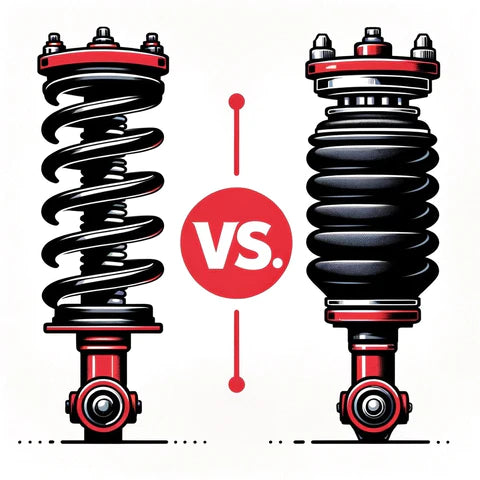Automotive suspension is crucial for providing a smooth and comfortable ride, keeping the tires firmly planted on the road, and handling perfectly in corners. Two popular suspension upgrades are coilovers and air suspension. But what's the difference, and which is better for your needs? This article will compare and contrast coilovers and air suspension.
What are Coilovers?
Coilovers are specially designed shock absorbers with height-adjustable springs built around them as a single integrated unit. They allow you to tune the ride height, shock damping, spring rates, and overall suspension geometry for improved handling, comfort, and style.
Coilovers get their name from having a coil spring mounted around the shock body, or "over" it. On a standard suspension, the springs and shocks are separate components. Coilovers combine them into a single, adjustable, high-performance unit.
Key Features of Coilovers:
- Height adjustability - threaded spring perches allow lowering or raising the car
- Damping adjustability - controls rebound and compression to fine-tune ride quality
- Spring rate adjustability - use stiffer or softer springs depending on application
- Corner balancing - each wheel's height can be set independently
- Integrated design - matched shock and spring give greater performance
Coilovers allow for extensive fine-tuning and customization for the street, track, or show. Lowering your vehicle over high-performance tires also provides an aggressive stance desired by many enthusiasts. High-end models from brands like Ridetech are very high quality. But affordable options from Viking Performance for example provide budget-minded enthusiasts with similar adjustability around $1000 or less.
Pros of Coilovers:
- Adjustability for the perfect ride and handling balance
- Lower vehicle height for improved style and performance
- Corner balancing for optimal traction and control
- Race-ready performance with excellent handling and response
Cons of Coilovers:
- Can be expensive for high-end models
- Lowered height may scrape on steep driveways or speed bumps
- Stiffer springs may increase road noise and vibration
- Improper installation can negatively impact performance
What is Air Suspension?
Air suspension does away with standard steel springs and replaces them with inflatable air bags or bellows. The air pressure in the bags essentially acts as the vehicle's springs. Air pressure can be increased to raise the vehicle or decreased to lower it using an on-board air compressor.
Key Components of Air Suspension:
- Air bags - provide cushioning and support instead of springs
- Compressor - pumps air into the suspension system
- Control arms - locate the wheels and control geometry
- Shock absorbers - dampen motion and cushion the ride
- Height sensors - monitor vehicle ride height
- Control module - automatically adjusts air pressure to maintain ride height
Air suspension allows drivers to easily change the ride height for clearance over obstacles, slammed stance when parked, and optimal aerodynamics on the highway. The constant adjustment of pressures also results in a smooth ride over uneven pavement.
Some manufacturers like Mercedes and Range Rover have offered air suspensions for decades. But universal aftermarket air suspension kits are also available to upgrade almost any vehicle. Air lift and Ridetech are two of the most popular brands, ranging from $1500 to over $5000 for a full kit.
Pros of Air Suspension:
- On-the-fly adjustability of ride height
- Smoother ride quality over uneven surfaces
- EasyHeight access mode to clear steep driveways
- Aerodynamic benefits from lowering at speed
Cons of Air Suspension:
- Complex components lead to higher cost
- Can "bottom out" if air pressure is lost
- Compressor noise is audible when adjusting
- Air bags can develop leaks over time
Coilovers vs Air Suspension Key Differences:
- Coilovers offer more performance-oriented handling and adjustment but require mechanical skills. Air offers simplicity and a plush street ride but is more complex and expensive.
- Coilovers lower the vehicle height permanently with fixed springs. Air allows freely adjustable height using air pressure.
- Coilovers are rebuilt from the standard suspension with integrated matched components. Air is adapted into the suspension design using bags and compressors.
- Coilovers excel at firming up and lowering a vehicle for track-ready handling. Air excels at providing a soft and personalized ride height for cruising.
Which Suspension is Right for You?

Choosing between coilovers and air suspension depends greatly on your vehicle, budget, driving priorities, and willingness to get hands-on with adjustments.
For serious performance, track days, or autocross, coilovers are the way to go. Their lower unibody position, stiff springs, and damping adjustments provide a real performance edge. Lowering your center of gravity over wider tires also helps immensely when pushing your car's handling limits.
If you just want to modernize your daily driver with a cool change of stance and smooth street ride, air may be the better choice. The ability to raise the vehicle up over obstacles and dial in the perfect ride softness has great appeal for a cruiser. Air also works great on heavy vehicles like SUVs and trucks where the mass requires the additional support.
The ideal solution may be to combine the performance adjustability of a coilover shock with the suspension height adjustability of an air ride system. You can do this by using an air suspension system with an adjustable shock. The smooth body adjustable shock absorber from Viking Performance will allow you to adjust both compression and rebound. This way you can slam your ride for shows, raise it up to clear your driveway, and adjust suspension performance for racing or autocross.
In summary, coilovers and air suspension appeal to different users with different priorities. Understanding their key differences allows you to decide which technology better matches your vehicle needs and budget. With the right suspension upgrade, you can maximize the potential of your car for any driving lifestyle.

